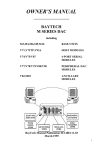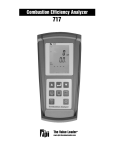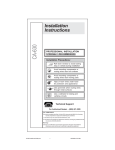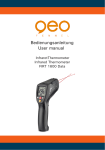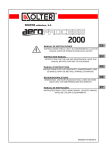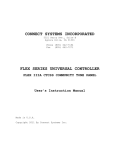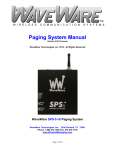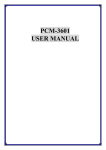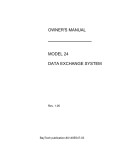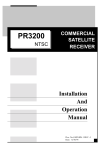Download Bay Technical Associates V80 PDI-2 Owner`s manual
Transcript
OWNER'S MANUAL ________________ MODEL V79 PDI-1 AND V80 PDI-2 SWITCH INPUT AND OPTICALLY ISOLATED INPUT MODULES BayTech Publication #U140E105 Thank you for selecting a BayTech Model V79 PDI-1 Switch Input Module or Model V80 PDI-2 Optically Isolated Input Module. The data provided in this Owner's Manual explains the various ways you can operate the V79 PDI-1 or V80 PDI-2, and how to configure your unit. We suggest that you read this manual carefully before attempting to install a PDI, and that you place special emphasis on correct cabling and configuration. If you have any problems with your installation, please contact a BayTech applications engineer for assistance. BayTech also manufactures other data communications devices that provide port sharing and expansion, networking, port contention, buffered and non-buffered printer sharing, network print servers, and statistical multiplexing. If you would like information on any of these models, please contact BayTech Customer Service. We welcome any comments you may have about our products. And we hope that you will continue to look to BayTech for your data collection and communications needs. NOTE: The information contained in this document is subject to change without notice. Copyright 1994 by Bay Technical Associates, Inc. IBM, IBM PC, IBM PC/AT, IBM PC/XT are products and registered trademarks of International Business Machines Corporation. Hewlett-Packard LaserJet and Draftmaster I Plotter are products and registered trademarks of the Hewlett-Packard Company. TABLE OF CONTENTS 1 GENERAL............................................................................................................................................................................................ 1 1.1 1.2 2 SPECIFICATIONS............................................................................................................................................................................... 3 2.1 2.2 3 V79 PDI-1 SWITCH INPUT STATUS MODULE.................................................................................................... 3 V80 PDI-2 OPTICALLY ISOLATED INPUT MODULE ....................................................................................... 4 INSTALLATION................................................................................................................................................................................. 5 3.1 3.2 4 V79 PDI-1 MODULE.................................................................................................................................................. 2 V80 PDI-2 MODULE.................................................................................................................................................. 2 CABLING..................................................................................................................................................................... 5 PDI-2 AC INPUT SETUP........................................................................................................................................... 6 OPERATION ....................................................................................................................................................................................... 7 4.1 4.2 GENERAL.................................................................................................................................................................... 7 USER-PROGRAMMABLE FEATURES.................................................................................................................... 8 4.2.1 4.2.2 SAMPLING SETUP ............................................................................................................................ 8 REPORTING SETUP .......................................................................................................................... 8 4.2.2.1 4.2.2.2 4.2.2.3 4.2.2.4 4.2.2.5 4.2.2.6 4.2.3 4.3 DYNAMIC CONFIGURATION....................................................................................................... 10 DATA COMMANDS................................................................................................................................................. 10 4.3.1 4.3.2 4.3.3 4.3.4 4.3.5 4.3.6 4.3.7 4.3.8 4.3.9 4.3.10 4.4 4.5 REPORTING METHOD ............................................................................................. 8 REPORT START TIME............................................................................................... 9 REPORT INTERVAL.................................................................................................. 9 HOST ADDRESS ......................................................................................................... 9 TIME TAG ................................................................................................................... 9 TERMINATING CHARACTER(S) .......................................................................... 10 CLEAR EVENT BUFFER COMMAND ........................................................................................... CLEAR EVENT COUNTER COMMAND....................................................................................... CLEAR EVENT LATCH DATA ...................................................................................................... REPORT ALL BUFFERED EVENTS COMMAND ........................................................................ REPORT EVENT COUNTER COMMAND .................................................................................... REPORT EVENT DURATION COMMAND.................................................................................. REPORT EVENT LATCH DATA COMMAND ............................................................................. REPORT EVENT COUNTER AND RESET COMMAND ............................................................. REPORT EVENT LATCH DATA AND RESET COMMAND ...................................................... REPORT A SINGLE BUFFERED EVENT COMMAND................................................................ 12 12 12 13 13 13 14 14 14 15 EVENT SAMPLE REPORTING .............................................................................................................................. 15 EVENT SAMPLE PRESENTATION....................................................................................................................... 17 5 CONFIGURATION ........................................................................................................................................................................... 19 5.1 MENU-DRIVEN CONFIGURATION ..................................................................................................................... 19 5.1.1 5.1.2 5.1.3 5.1.4 5.1.5 5.1.6 5.2 21 22 22 23 5.1.4.1 5.1.4.2 5.1.4.3 5.1.4.4 5.1.4.5 5.1.4.6 24 25 26 27 27 28 REPORTING METHOD ........................................................................................... REPORT START TIME............................................................................................. REPORT INTERVAL................................................................................................ HOST ADDRESS ....................................................................................................... TIME TAG ................................................................................................................. TERMINATING CHARACTER(S) .......................................................................... DYNAMIC CONFIGURATION....................................................................................................... 28 EXIT ................................................................................................................................................... 29 DYNAMIC CONFIGURATION PROCEDURE AND COMMANDS................................................................... 30 5.2.1 5.2.2 5.2.3 5.3 CONFIGURATION MAIN MENU .................................................................................................. MODULE STATUS........................................................................................................................... SAMPLING SETUP .......................................................................................................................... REPORTING SETUP ........................................................................................................................ DEBOUNCE DELAY COMMAND ................................................................................................. 31 REPORTING METHOD COMMAND............................................................................................. 31 TIME TAG COMMAND................................................................................................................... 31 FRONT PANEL CONFIGURATION....................................................................................................................... 32 APPENDIX A DATA/CONFIGURATION COMMAND SUMMARY ........................................................................................................................................... 33 APPENDIX B EPROM UPGRADE .................................................................................................................................................................................................. 34 APPENDIX C V79 PDI-1 MECHANICAL LAYOUT .................................................................................................................................................................... 35 APPENDIX D V80 PDI-2 MECHANICAL LAYOUT .................................................................................................................................................................... 36 APPENDIX E INDEX........................................................................................................................................................................................................................ 37 1 GENERAL BayTech's PDI modules are designed for use with the M16 and M8 (DAC) Data Acquisition Controllers. Both modules are used to detect events where an event is defined as a change-in-state of an input and return to the original state. The V79 PDI-1 module is used for the detection of switch closure in applications requiring notification of device status such as burglar alarms, fire alarms, event counters and timers, process control, etc.. The V80 PDI-2 is used for the detection of optically isolated voltage inputs in applications requiring industrial control of motors, process monitoring, limit switch status, and the monitoring of relay status. All events detected by either module are recorded as an event sample and sent to a host computer/controller connected to a V71 host module. The current status of input channels may be provided to the host computer/controller upon request. Event samples or input channel status may be provided with a "time stamp" or "Time Tag" which is available through the use of a "time-of-day" clock located in the M16/M8 base unit. A time tag includes the month, day, year, hour, minute and second the event occurred or the input channel status was taken. Event status is supplied to the host computer/controller in one of the following modes: 1) 2) 3) Upon user request (COMMAND). At a specific date/time (SCHEDULE). Real time reporting of events (i.e., as events occur IMMEDIATE). 1 1.1 V79 PDI-1 MODULE The main features of the V79 PDI-1 module are sixteen microprocessor-controlled input channels that can be connected with individual ground returns, or a common single-point ground. The input channels provide a flexible, reliable method to detect and report the change-in-state of a circuit. The change can be from infinite resistance (open) to continuity (closed), and vice versa. For example, the changein-state could be for a set of form C (dry) relays or switch contacts. Any change in the status of individual or multiple inputs may be observed, recorded, reported, analyzed, and acted upon. The level and type of actions desired or required are easily selectable through the PDI-1's configuration menu. Individual or multiple inputs may be polled for present status or configured to automatically provide an alert message when a change-in-state is observed. Momentary changes in an input's condition can be monitored and "latched" into memory for post-action analysis. The reporting of false, or transient events can be prevented by selection of programmable "debounce times". Input connections to the PDI-1 are made through a standard DC-37F connector. 1.2 V80 PDI-2 MODULE The primary feature of the PDI-2 series is sixteen microprocessor controlled, optically isolated voltage inputs. The PDI-2A is designed for an input "on" voltage range of 5 to 24 AC or DC volts and the PDI-2B for 100 to 130 AC or DC volts. All inputs have 500V AC or DC electrical isolation from ground. Inputs are not polarity sensitive. Therefore, paired signal inputs can be made using the "return" or "input" terminal as the positive connection. A mixture of AC and DC inputs can be selected by individual channels. For example, Channel 1 could be a DC input, Channels 2 and 3 AC inputs, Channel 4 a DC input, etc.. Dip switches are provided for selection of low-pass filtering during AC input operation. 2 These optically isolated inputs provide an efficient means for the monitoring of external process and control functions. All functions provided by the board are programmable through a series of detailed configuration menus. Additional functionality is made available through the use of BayTech or user provided application software. Input connections to the PDI-2 are made through a standard DC-37F connector. 2 SPECIFICATIONS 2.1 V79 PDI-1 SWITCH INPUT STATUS MODULE (typical for 25o C unless otherwise noted) INPUTS: 16 with individual ground returns or common (single-point) ground. DRIVE DISTANCE: Up to 1000 Ohms cable resistance, for example: AWG 36 - 2400 ft., AWG 24 - 15000 ft., AWG 22 62000 ft. POWER REQUIREMENTS: +5VDC, 40 ma typical (provided by M16/M8 pwr supply). DEBOUNCE: 0 to 60000 ms (software selectable). ENVIRONMENTAL: o o Operating temperature range: 0 to 70 C o o Storage temperature range: -40 to 85 C Humidity: 5% to 95% non-condensing 3 2.2 V80 PDI-2 OPTICALLY ISOLATED INPUT MODULE MODULE TYPE PDI-2A PDI-2B NUMBER OF INPUTS: 16 16 INPUT VOLTAGE RANGE: 5-24 100-130 MAXIMUM INPUT CURRENT: 50ma 20ma MINIMUM TURN ON CURRENT:8ma 8ma MAX TURN ON TIME: 1ms 1ms MAX TURN OFF TIME: 1ms 1ms VOLTAGE ISOLATION: AC/DC 500V 500V (Input to Input and Input to ground) POWER REQUIREMENTS: +5VDC, 40 ma typical (provided by M16/M8 pwr supply) DEBOUNCE TIME: 0 to 60000 ms (software selectable) ENVIRONMENTAL: o o Operating temperature range: 0 to 70 C o o Storage temperature range: -40 to 85 C Humidity: 5% to 95% non-condensing 4 3 INSTALLATION The PDI-1 and PDI-2 are installed in the M Series chassis as described in Section 3.5 of the base unit operator's manual. NOTE: The PDI-1 or PDI-2 cannot be installed as Module 1. If an PDI-1 or PDI- 2 is removed from a module slot and a different PDI-1 or PDI-2 is installed in that location, the newly installed module acquires the previous module's configuration. Moving an PDI-1 or PDI-2 to a different module location requires reconfiguration because the configuration parameters are stored as a function of slot location and module type. The configuration information does not stay with a relocated module. 3.1 CABLING The V79 PDI-1 and V80 PDI-2 modules each have a DC-37F connector. Equipment connections for each module is similar. Each input of the V79 module has a ground connection and each input of the V80 module has a return connection. Figure 1 and Figure 2 below show the V79 and V80 connections respectively. Circuit Pin # Connection Circuit Connection Input #1 1 20 Ground #10 Ground #1 2 21 Input #11 Input #2 3 22 Ground #11 Ground #2 4 23 Input #12 Input #3 5 24 Ground #12 Ground #3 6 25 Input #13 Input #4 7 26 Ground #13 Ground #4 8 27 Input #14 Input #5 9 28 Ground #14 Ground #5 10 29 Input #15 Input #6 11 30 Ground #15 Ground #6 12 31 Input #16 Input #7 13 32 Ground #16 Ground #7 14 33 N.C. Input #8 15 34 N.C. Ground #8 16 35 N.C. Input #9 17 36 N.C. Ground #9 18 37 N.C. Input #10 19 Circuit Connection Pin # Circuit Connection Input #1 1 20 Return #10 Return #1 2 21 Input #11 Input #2 3 22 Return #11 Return #2 4 23 Input #12 Input #3 5 24 Return #12 Return #3 6 25 Input #13 Input #4 7 26 Return #13 Return #4 8 27 Input #14 Input #5 9 28 Return #14 Return #5 10 29 Input #15 Input #6 11 30 Return #15 Return #6 12 31 Input #16 Input #7 13 32 Return #16 Return #7 14 33 N.C. Input #8 15 34 N.C. Return #8 16 35 N.C. Input #9 17 36 N.C. Return #9 18 37 N.C. Input #10 19 Figure 1 : V 7 9 I n p u t C o n n e c t i o n s Figure 2 : V 8 0 I n p u t C o n n e c t i o n s 5 3.2 PDI-2 AC INPUT SETUP The PDI-2 module has two banks of dip switches which are used to add ripple filtering for AC inputs. AC input is selected by individual channel. Location of the dip switches is shown in Figure 3. CHANNEL SW1 1 2 3 4 5 6 7 8 9 10 11 12 13 14 15 16 1 2 3 4 5 6 7 8 SW2 Figure 3 1 2 3 4 5 6 7 8 Table 1 Dip switch SW1 1-8 provides filtering control for channels 1-8 while SW2 1-8 controls channels 9-16. Refer to Table 1 to determine which switch corresponds to a particular channel. A port is configured for AC operation by positioning the corresponding switch to ON position. NOTE: The default setting for SW 1-8 and SW2 1-8 is "OFF" (AC filtering disabled). 6 4 OPERATION This section discusses the general PDI operation (Section 4.1), user-programmable features (Section 4.2), data commands (Section 4.3), event sample reporting (Section 4.4), and presentation (Section 4.5). 4.1 GENERAL The V79 PDI-1 and V80 PDI-2 modules are used in applications requiring notification of device status (e.g., burglar and fire alarms, event counters/timers, process control, etc.). The PDI-1 module has 16 channel switch inputs providing a reliable method to detect and report a state change from high resistance (open) to continuity (closed) or vice versa. The V80 is a 16 channel optically-isolated voltage input module that is non-polarity sensitive and can be individually set to detect the presence or the change of state of AC or DC inputs. We will refer to a change in state of a switch closure (PDI-1) or a voltage change (PDI-2) as an event. An event sample is the actual data associated with an event which is calculated by the PDI module and sent to the host computer/controller. Individual PDI channels can be programmed to report event samples upon request via data commands (Command Reporting Method), at a specific date/time (Schedule Reporting Method), or as the event occurs (Immediate Reporting Method). Multiple events may be stored for later retrieval and analysis. The PDI features a latch mode where the time and state of the initial event is latched and held until user reset. False reporting of events is prevented by programming variable debounce times. Event samples are preceded by the appropriate unit, module, and channel number and may be appended with a "real time" Time Tag showing the date and time the status was recorded. You have the choice of programming the PDI via verbose (menu-driven) or nonverbose (dynamic) configuration mode. When using verbose mode, a series of menus will prompt you to enter the desired parameters. Non-verbose mode allows you to program the PDI by downloading configuration commands (see Section 5.2). 7 4.2 USER-PROGRAMMABLE FEATURES You may program the Sampling Setup, Reporting Setup, and Dynamic Configuration on the PDI which are discussed in Section 4.2.1 through Section 4.2.3 respectively. 4.2.1 SAMPLING SETUP Sampling Setup allows you to program the Debounce Delay and Latch Polarity for the input channels. The Debounce Delay is used to guard against erroneous events. An event will not be valid unless the input channel has remained at a changed state for the debounce duration. The debounce delay may be programmed from 0 (for no debounce) to 65535 milliseconds. The Latch Polarity is used to latch individual inputs based on a positive going (LO to HI) or negative going (HI to LO) input. The latch information is retained in memory until recalled by the user. The default Debounce Delay time is 100 milliseconds and the default Latch Polarity is a HI to LO transition. 4.2.2 REPORTING SETUP Reporting Setup allows you to program how the PDI reports event samples to the host module. The items you may program in the Reporting Setup include Reporting Method, Report Start Time, Report Interval, Set Host Address, Data Format, Time Tag, and Terminating Character(s). The following subsections describe these features in more detail. 4.2.2.1 REPORTING METHOD Reporting Method is the manner in which event samples are sent to the designated host module. The PDI provides three Reporting Methods: Command (upon request via data commands), Immediate (upon exiting configuration), and Schedule (where reporting begins at a specified time). The default Reporting Method is Command. 8 4.2.2.2 REPORT START TIME Report Start Time is the time reporting begins when Schedule Reporting Method is selected. The start of reporting may be delayed up to 24 hours from the current time recorded by the M Series time-of-day clock and reporting will occur in cyclic periods as determined by the Report Interval. The default Report Start Time is 00:00. 4.2.2.3 REPORT INTERVAL You may program the PDI to report in repetitive periods using Schedule Reporting Method, where the PDI will report all event samples in the receive buffer after the specified Report Interval has elapsed. The PDI will report until the buffer is empty and then report again after the specified Report Interval has expired. The default Report Interval is 00:00 (every 24 hours). 4.2.2.4 HOST ADDRESS Host Address is the designated host module where event samples are sent when using Immediate or Schedule Reporting Method. The Host Address consists of the Unit Number (1 to 32), Module Number (1 to 16), and Port Number (1 to 4) of the designated host module. The default Host Address is Unit 1, Module 1, Port 1. 4.2.2.5 TIME TAG When Time Tag is enabled, a time tag is appended immediately after the event sample. The time tag consists of the month, day, year, hour, minute, and second at which the data was calculated. Time Tag may be enabled or disabled. The default Time Tag is disabled. 9 4.2.2.6 TERMINATING CHARACTER(S) The Terminating Character(s) is added at the end of an event sample to match the requirements of the host terminal or application software. The Terminating Character(s) consists of one or two hexadecimal characters. The default Terminating Characters are 0D Hex (Carriage Return) followed by 0A Hex (Line Feed). 4.2.3 DYNAMIC CONFIGURATION You may enable or disable Dynamic Configuration for the PDI. Dynamic configuration mode allows non-verbose or "on-the-fly" configuration commands to be issued to the PDI which are summarized in Section 5.2. The default Dynamic Configuration setting is disabled. 4.3 DATA COMMANDS You may issue PDI data commands through a host module to perform single operations while temporarily overriding the module's current operating configuration. Some data commands apply to all types of DAC modules, while others apply to specific modules. Data commands may be entered repeatedly to get specific event samples. You may issue a single data command to obtain event samples from multiple channels. Data commands must be used to obtain event samples when using Command Reporting Method. PDI data commands are sent through a host module using the following procedure: 1. 10 Select the PDI from the host module by sending a select sequence which consists of the port select code ($BT - default), the desired module number (2 to 16), and a terminating character of Carriage Return (0D Hex) or Line Feed (0A Hex). For example, to select an PDI Module located in slot 15 using the default port select code, send $BT15<cr>. 2. Once the PDI is selected, it will go into Command Mode and allow you to send data commands. The PDI data commands begin with two capital letters designating the specific command and are terminated with a Carriage Return. Most data commands also require a number between the command letters and Carriage Return. This number is typically the desired channel(s) for the data command. If you have a requirement to send the data command to multiple channels simultaneously, you may use one of the following formats as shown for the SA (sample) command: SA1,2,3,4,5,6,7,8<cr> SA1-8<cr> SA/0 <cr> SA1,2,4-8<cr> 3. Take a single sample for Ports 1-8 Take a single sample for Ports 1-8 Take a single sample for Ports 1-8 Take a single sample for Ports 1, 3, 4, 5, 6, 7, and 8 After you have sent the desired data commands to the PDI module, you may disconnect from the PDI by sending $BT<cr>. You may disconnect from the PDI and select a different module or the base unit by sending $BTX<cr>, where X is the desired module number or 0 for the base unit. IMPORTANT: If the PDI is operating in self reporting mode (i.e., Immediate or Schedule Reporting Method) and a host device issues a data command, the host device must disconnect by sending the Port Select Code and Carriage Return or Line Feed before the PDI will resume sending event samples to the designated host module. Section 4.3.1 through Section 4.3.10 provide detailed information on the functionality of each data command supported by the PDI. Appendix A provides these same commands in a condensed version for quick reference. 11 4.3.1 CLEAR EVENT BUFFER COMMAND The Clear Event Buffer (CB) command is used to clear all stored event samples from the buffer of the selected channel(s). The Clear Event Buffer command has the following format: CB n<cr> where c = Channel# (1 to 16 or 0 for all). 4.3.2 CLEAR EVENT COUNTER COMMAND The Clear Event Counter (CC) command is used to reset the event counter for one or more channels to zero without reading the value of the event counter. The function of the event counters is discussed in Section 4.4. The Clear Event Counter command has the following format: CCc<cr> where c = Channel# (1 to 16 or 0 for all). 4.3.3 CLEAR EVENT LATCH DATA The Clear Event Counter (CR) command is used to clear the event latch buffer. Latched data is discussed more in Section 4.4. The Clear Event Counter command has the following format: CRc<cr> where c = Channel# (1 to 16 or 0 for all). 12 4.3.4 REPORT ALL BUFFERED EVENTS COMMAND The Report All Buffered Events (RA) command instructs the PDI to report all event samples currently stored in the buffer of the selected channel(s). The Report All Buffered Events command has the following format: RAn<cr> where c = Channel# (1 to 16 or 0 for all). 4.3.5 REPORT EVENT COUNTER COMMAND The Report Event Counter (RC) command instructs the PDI to report how many times an event has occurred for one or more channels since the last time a counter reset command was issued. This command does not reset the event counter. The Report Event Counter command has the following format: RCc<cr> where c = Channel# (1 to 16 or 0 for all). 4.3.6 REPORT EVENT DURATION COMMAND The Report Event Duration (RD) command instructs the PDI to report how long the most recent recorded event for the selected channel(s) lasted. Event duration is discussed more in Section 4.4. The Report Event Duration command has the following format: RDc<cr> where c = Channel# (1 to 16 or 0 for all). 13 4.3.7 REPORT EVENT LATCH DATA COMMAND The Report Event Latch Data (RL) command instructs the PDI to report the active state of the initial event and the time the initial event occurred (if time tagging is enabled). This command does not reset the latch buffer. The Report Event Latch Data has the following format: RLc<cr> where c = Channel# (1 to 16 or 0 for all). 4.3.8 REPORT EVENT COUNTER AND RESET COMMAND The Report Event Counter and Reset (RO) command instructs the PDI to report how many times an event has occurred for one or more channels and then reset the event counter to zero. The Report Event Counter and Reset command has the following format: ROc<cr> where c = Channel# (1 to 16 or 0 for all). 4.3.9 REPORT EVENT LATCH DATA AND RESET COMMAND The Report Event Latch Data and Reset (RR) command instructs the PDI to report the active state of the initial event, the time the initial event occurred (if time tagging is enabled), and then reset the latch buffer. The Report Event Latch Data and Reset command has the following format: RRc<cr> where c = Channel# (1 to 16 or 0 for all). 14 4.3.10 REPORT A SINGLE BUFFERED EVENT COMMAND The Report A Single Buffered Event (RS) command instructs the PDI to report the first event sample stored in the buffer of the selected channel(s). The Report A Single Buffer Sample command has the following format: RS c<cr> where c = Channel# (1 to 16 or 0 for all). 4.4 EVENT SAMPLE REPORTING An event is defined as a change-in-state of an input channel and return to the original state. An event may be started on a rising edge (LO to HI) or a falling edge (HI to LO) as determined by the Latch Polarity (see Section 5.1.3). On the PDI-1 switch closure module, an input is considered to be at a "HI" or "1" state when it is closed (continuity) and a "LO" or "0" state when it is open (infinite resistance). On the PDI-2A and PDI-2B optically isolated modules, an input is considered to be at a "HI" or "1" state when there is voltage detected and a "LO" or "0" state whenever there is no voltage detected. An event sample is the actual data associated with an event which is calculated by the PDI module and sent to the host computer/controller. The way an event sample is presented to the host computer/controller is described in Section 4.5. PDI event sample reporting depends on the Reporting Method used. When using Immediate Reporting Method, the PDI will report an event sample whenever an event occurs. When using Schedule Reporting Method, the PDI will report an event sample whenever a event occurs after the Report Start Time has elapsed (see Section 4.2.2.2). When using Command Reporting Method, the PDI will report an event sample or multiple samples on command only. 15 The PDI module can observe, record, and report when an event happened, how long the event lasted, and how many events occurred for each individual channel. The initial occurrence of an event will set the event latch bit and store the associated time in the latch buffer. You may read the state of the initial event and the time it was recorded (if time tagging is enabled) by issuing the RL or RR commands. Each occurrence of an event starts the duration counter and increments the event counter. The duration counter measures event duration time in milliseconds with a maximum time of 65,535 stored. You may read the duration of the last recorded event by issuing the RD command. NOTE: Duration measurements are not de-bounced. If the input circuit cycles between active and inactive before settling, only the settled value is reported. Therefore, if a PDI module is connected to a relay or switch that has "dirty" contacts, the total measurement will be less than the actual activation duration of the circuit by the amount of time spent settling. The event counter reflects the total number of events that have occurred since the event counter was last cleared using the CC or RO command. You may read the current event counter value by sending the RC or RO command. The event counter will trigger on the rising edge of an event when LO to HI Latch Polarity is selected or on the falling edge of an event when HI to LO Latch Polarity is selected. Examples of using the event counter would include counting items moving on a conveyor belt and process control where a pre-determined number of events must take place before a defined action may take place. NOTE: An event must have a duration greater than one millisecond plus the current debounce delay time to increment the event counter. 16 4.5 EVENT SAMPLE PRESENTATION Event Sample presentation varies slightly in format depending on module configuration. Entries such as, time tag, data format, number of active channels, etc. all change how event samples appear to a host-controller. However, all event samples are presented in the same basic order of fields as follows: UU:MM,CC 1 or 0 MM/DD/YY HH:MM:SS where, UU is the M Series Unit Number MM is the PDI Module Number CC is the PDI Channel Number 1 channel status is "closed" (PDI-1) or has voltage applied (PDI-2) 0 channel status is "open" (PDI-2) or has no voltage applied (PDI-2) MM is the month (if Time Tag enabled) DD is the day (if Time Tag enabled) YY is the year (if Time Tag enabled) HH is the hour (if Time Tag enabled) MM is the minute (if Time Tag enabled) SS is the second (if Time Tag enabled) The following example shows event samples received using immediate or schedule reporting where the PDI is installed in Unit 1 Module 15 with Time Tagging enabled: UNIT# MODULE# CHANNEL# CHANNEL STATUS DATE TIME 1:15,1 1 11/18/93 09:12:22<cr><lf> 1:15,2 1 11/18/93 09:12:22<cr><lf> 17 The following examples show the messages received using data commands where the PDI is installed in Unit 1 Module 15 with time tagging enabled. If you select the module and issue the RD1<cr> command (Report Event Duration for Channel 1), the module will respond with a single message showing the Event Duration for Channel 1 similar to the following: 1:15,1 1320 11/18/93 09:12:22 where 1:15,1 represents Unit 1/Module 15/Channel 1, 1320 indicates the event duration is 1320 milliseconds, and 11/18/93 09:12:22 is the time tag. If you issue the RC1<cr> command (Report Event Counter for Channel 1), the module will respond with a message showing the Event Counter similar to the following: 1:15,1 823 11/18/93 09:12:22 where 1:15,1 represents Unit 1/Module 15/Channel 1, 823 indicates the number of recorded events is 823 times, and 11/18/93 09:12:22 is the time tag. If you issue the RS1<cr> command (Report Single Buffered Event for Channel 1), the module will respond with a message showing the input status for Channel 1 similar to the following: 1:15,1 1 11/18/93 09:12:22 where 1:15,1 represents Unit 1/Module 15/Channel 1, 1 indicates the first buffered sample for Channel 1 is closed (PDI-1) or has voltage applied (PDI-2), and 11/18/93 09:12:22 is the time tag. 18 If you issue the RL1<cr> command (Report Event Latch Data for Channel 1), the module will respond with a message showing the state of the input that started the initial event. This will be "1" (closed) for LO to HI Latch Polarity or "0" (open) for HI to LO Latch Polarity if using the PDI-1. This will be "1" (voltage detected) for LO to HI Latch Polartiy or "0" (no voltage detected) for HI to LO Latch Polarity if using the PDI-2. If time tagging is enabled, the time the initial event occurred will be appended to the event sample. 5 CONFIGURATION You may program the PDI-1 or PDI-2 using a menu-driven configuration procedure from a host module or the M Series service port as described in Section 5.1 or by sending dynamic configuration commands from a host module as described in Section 5.2. You may view the current configuration from the front panel (see Section 5.3). 5.1 MENU-DRIVEN CONFIGURATION To access the menu-driven configuration mode of the PDI-1 or PDI-2 from any host module, use the following procedure: 1. Configure the host terminal's serial parameters to match those of the host module. From the factory, the host module is set at 9600 baud, 8 bit word size, 1 stop bit, no parity, and XON/XOFF disabled. If you do not have a dumb terminal or a terminal emulation program, BayTech supplies a utility diskette which includes software to put an IBM PC or compatible into a terminal mode (TERM.EXE). 2. Connect to the PDI by sending the port select code, the appropriate Unit Number followed by a colon (1: to 30: - only if using cascaded units), the desired module number (2 to 16), and Carriage Return or Line Feed. 3. Access configuration mode by sending $CONFIG<cr>. 19 For example, if the PDI is installed in a non-cascaded unit as Module 2 and you are using the default port select code ($BT), send $BT2<cr>$CONFIG<cr> to enter into configuration mode. No characters should be typed between $BT2<cr> and $CONFIG<cr>. If this happens, the entire configuration sequence will be discarded and you will have to send the configuration sequence again. NOTE: All commands must be in uppercase. To access the menu-driven configuration mode of the PDI from the service port, use the following procedure: 1. Connect a terminal to the EIA-232 service port and configure the terminal's serial parameters to 9600 baud rate, 8 word size, 1 stop bit, and no parity. 2. Connect to the PDI by sending $BAYTECH, the desired module number (2 to 16), and Carriage Return or Line Feed. 3. Access configuration mode by sending $CONFIG<cr>. Following the example on the previous page, you would send $BAYTECH2<cr>$CONFIG<cr> to configure Module 2. NOTE: All commands must be in uppercase. 20 5.1.1 CONFIGURATION MAIN MENU A PDI-1 module installed as Module X will respond to the receiving of $CONFIG<cr> with an identification block and a menu of the available configuration options similar to the following: Copyright (c) Bay Technical Associates,1993 DAC V79 PDI-1 Rev. 1.XX This Module is X CONFIGURATION MAIN MENU Module Status......................1 Sampling Setup.....................2 Reporting Setup....................3 Dynamic Configuration..............4 Exit...............................X Enter Selection: NOTE: The only difference in the configuration main menu for the PDI-1 or PDI- 2 modules is the second line in the header showing the module type. All subsequent menus are the same for both modules. The configuration menus shown in the following sections are depicted with factory default settings and may vary slightly in presentation. Enter the number corresponding to your desired choice. Each choice will invoke a sub-menu. Each sub-menu is described in the following sections. When you exit a sub-menu, you will be returned to the configuration main menu. When "Exit" is selected from the main menu, the PDI will exit from configuration mode and go into an active data collection mode. 21 5.1.2 MODULE STATUS By responding to the Enter Selection: message at the end of the Configuration Main Menu (see Section 5.1.1) with "1" (Module Status), you may review the current configuration status. The PDI will respond with a menu similar to the following: MODULE STATUS Debounce Delay (Milliseconds)......100 Latch Polarity.....................LO to HI Reporting Method...................COMMAND Reporting Start Time...............24:00 Reporting Period...................24:00 Host Address.......................1:1,1 Data Format........................HEX Time Tagging.......................DISABLED Terminating Character(s)...........0D0A Dynamic Configuration..............DISABLED Press a key to continue or X to Exit. 5.1.3 SAMPLING SETUP By responding to the Enter Selection: message at the end of the Configuration Main Menu (see Section 5.1.1) with "2" (Sampling Setup), you may program the Debounce Delay and Latch Polarity. The PDI will respond with the following menu: SAMPLING SETUP Debounce Delay..................1 Latch Polarity..................2 Exit............................X Enter Selection: You may program the Debounce Delay the Latch Polarity from this menu. The Exit selection will return you to the configuration main menu. For example, if you type "1" (Debounce Delay), the PDI will respond with the following: SET DEBOUNCE DELAY (0-65535 Milliseconds) Debounce Delay.................100 Exit...........................X Enter Value<CR>, or X to EXIT: 22 Type the desired debounce delay time followed by <ENTER>. The debounce delay is used to guard against erroneous events. An event will not be valid unless the input channel has remained at a changed state for the debounce duration. If you type "2" from the "Sampling Setup" menu shown on the previous page (Latch Polarity), the PDI will respond with the following: SET LATCH POLARITY Latch Polarity..................HI TO LO Low to Hi Transitions only......1 Hi to Low Transitions only......2 Exit............................X Enter Selection: Enter the desired Latch Polarity. The Latch Polarity is used to latch initial events for individual inputs based on a positive going (LO to HI) or negative going (HI to LO) input. 5.1.4 REPORTING SETUP By responding to the Enter Selection: message at the end of the Configuration Main Menu (see Section 5.1.1) with "3" (Reporting Setup), you may program how the PDI reports event samples to the host device. The items you may program are Reporting Method, Report Start Time, Report Interval, Host Address, Data Format, Time Tag, and Terminating Character(s). The operational functionality of these items is discussed in Section 4.2.2. The PDI will respond with the Reporting Setup menu as follows: REPORTING SETUP Reporting Method...................1 Report Start Time..................2 Report Interval....................3 Host Address.......................4 Time Tag...........................5 Terminating Character(s)...........6 Exit...............................X Enter Selection: 23 If you respond to one of the above selections with 1 to 6, a sub-menu will be presented for that item. After making any necessary changes under sub-menus 1 to 6, you be returned to the Reporting Setup menu. The "Exit" selection will return you to the Configuration Main Menu. 5.1.4.1 REPORTING METHOD By responding to the Enter Selection: message at the end of the Reporting Setup Menu with "1" (Reporting Method), you may program how the PDI reports event samples to the host device. The PDI will respond with the Select Reporting Method sub-menu as follows: SELECT REPORTING METHOD Reporting Method....................COMMAND Command............................1 Immediate (When Event Occurs)......2 Schedule...........................3 Exit...............................X Enter Selection: The PDI provides three Reporting Methods. These are Command (via data commands only), Immediate (upon exiting configuration), and Schedule (where reporting begins at a specified time). When Command Reporting Method is selected, the PDI will report event samples to the host module only when data commands are issued (see Section 4.3.). When Immediate Reporting Method is selected, the PDI will report event samples to the host module as events occur. If no event has occurred, no event sample is generated. Reporting begins immediately after exiting the Configuration Main Menu 24 When Schedule Reporting Method is selected, the PDI will begin reporting event samples as events occur at the programmed Report Start Time (see Section 5.1.4.2). The Report Start Time is programmable up to 24 hours in advance of the current (time-of-day) clock time. Event samples are stored in the buffer until the Report Start Time is reached at which time all buffered event samples are reported to the host module. Further reporting is based upon the selected Report Interval as explained in Section 5.1.4.3. 5.1.4.2 REPORT START TIME By responding to the Enter Selection: message at the end of the Reporting Setup Menu on page 23 with "2" (Report Start Time), you may program the time the PDI will start reporting when using Schedule Reporting Method. The PDI will respond with the Report Start Time menu as follows: REPORT START TIME Reporting Start Time...............HH:MM Current Date and Time..............MM/DD/YY HH:MM:SS Enter Hours (0-24) <cr>, or X to Exit: Enter Minutes (0-59) <cr>, or X to Exit: This menu shows the current Reporting Start Time, Current Date and Time as reported by the base unit's time-of day clock when the reporting start time entry was selected, and prompts you to enter the desired Report Start Time. Reporting can be delayed up to 24 hours from the current time. Enter the desired Report Start Time. For example, suppose the Current Time is 9:20:30 and the Reporting Start Time is set to 10:45. After you exit the Configuration Main Menu, the PDI will start reporting event samples at 10:45 at the programmed Sampling Setup. If the M Series loses power, reporting resumes the next time the designated Report Start Time is observed by the time-of day clock. 25 IMPORTANT: The Current Date and Time is not updated during data entry. You must consider any delays from the time you enter the Report Start Time until you exit the Configuration Main Menu. Be sure to set the Report Start Time far enough ahead of the current time to complete all configurations and exit configuration mode. NOTE: When using Schedule Reporting Method and the PDI is initially reporting, if you enter into the menu-driven mode of configuration and exit, the PDI will not resume reporting event samples until the programmed Report Start Time elapses. You may program the PDI without disrupting event sample reporting by using dynamic configuration (see Section 5.2). 5.1.4.3 REPORT INTERVAL By responding to the Enter Selection: message at the end of the Reporting Setup Menu on page 23 with "3" (Report Interval), you may program the time interval between reporting periods when using Schedule Reporting Method. The PDI will respond with the Report Interval menu as follows: REPORT INTERVAL Report Interval......................HH:MM Enter Hours (0-24) <cr>, or X to Exit: Enter Minutes (0-59) <cr>, or X to Exit: Enter the desired Report Interval. The Report Interval can range from 1 minute to 24 hours. Once the Report Start Time elapses, the PDI will report all buffered event samples to the designated host module until the buffer is empty. The PDI will continue to transmit all buffered event samples every time the Report Interval expires. For example, if the Report Start Time is 12:00 and the Report Interval is 1:00 (1 hour), the PDI will report all messages in its buffer every hour on the hour starting at 12:00. 26 5.1.4.4 HOST ADDRESS By responding to the Enter Selection: message at the end of the Reporting Setup Menu on page 23 with "4" (Host Address), you may program the address of the designated host module. The designated host module is where event samples are sent when using Immediate or Schedule Reporting Method. The PDI will respond with the Host Address menu as follows: HOST ADDRESS Host Address.......................1:1,1 Enter Unit Number (1-32) <cr>, or X to EXIT: Enter Module Number (1-16) <cr>, or X to EXIT: Enter Port Number (1-4) <cr>, or X to EXIT: Enter the appropriate Host Address. This consists of the Unit Number (1 to 32), Module Number (1 to 16), and Port Number (1 to 4) where the designated host module is located. Each entry should be followed by <ENTER>. If there is a single M Series unit in service, the Host Address would typically be Unit 1, Module 1, Port 1. NOTE: The Host Address must be supplied to direct self-reporting event samples to the desired destination. If the Host Address is incorrect, self-reporting event samples will be misdirected or lost. 5.1.4.5 TIME TAG By responding to the Enter Selection: message at the end of the Reporting Setup Menu on page 23 with "6" (Time Tag), you may program the PDI to append a time tag to the end of event samples automatically. The PDI will respond with the Enable/Disable Time Tagging menu as follows: ENABLE / DISABLE TIME TAGGING Time Tagging.......................DISABLED Enable.............................1 Disable............................2 Exit...............................X Enter Selection: 27 With time tag enabled, a MM/DD/YY HH/MM/SS entry is appended to all samples, where MM is the month, DD is the day, YY is the year, HH is the hour, MM is the minute, and SS is the second according to the base unit's time-of-day clock. 5.1.4.6 TERMINATING CHARACTER(S) By responding to the Enter Selection: message at the end of the Reporting Setup Menu on page 26 with "7" (Terminating Character(s)), you may program one or two characters to be appended at the end of each event sample. This option allows a user to match the host terminal and/or requirements of their application software. The PDI will respond with the Enter Terminating Character menu as follows: ENTER TERMINATING CHARACTER Terminating Character(s)...........0D0A Enter 1 or 2 Terminating Characters in Hex Format (i.e. 0D0A for CR+LF) <cr>, or X to Exit: Type the hexadecimal representation of the desired terminating character(s). For example, Carriage Return would be represented by 0D Hex and Line Feed would be represented by 0A Hex. NOTE: Only ASCII characters A-F and 0-9 are acceptable. 5.1.5 DYNAMIC CONFIGURATION By responding to the Enter Selection: message at the end of the Configuration Main Menu (see Section 5.1.1) with "5" (Dynamic Configuration), you may program the PDI to respond to dynamic configuration (non-verbose) commands. The PDI will respond with the Dynamic Configuration Commands menu as follows: DYNAMIC CONFIGURATION COMMANDS Dynamic Configuration Commands.....DISABLED Enable.............................1 Disable............................2 Exit...............................X Enter Selection: 28 Dynamic configuration mode allows the PDI to be programmed by downloading dynamic (on-the-fly) commands. See Section 5.2 for the procedure to program the PDI via dynamic configuration and a description of the available configuration commands. 5.1.6 EXIT By responding to the Enter Selection: message at the end of the Configuration Main Menu (see Section 5.1.1) with "X" (Exit), the PDI will exit the menu-driven configuration mode. If changes are made to any configuration parameter, the PDI will respond with: Save Changes as Defaults? (Y/N) If you reply in the affirmative (Y), the settings are saved as the permanent powerup defaults. That is, if the M16/M8 loses power for any reason, the settings saved as defaults become the power-up settings. If you reply in the negative (N), your selections are saved as current (temporary) operating settings, but are lost upon power-down. The most recent menu selections saved as Defaults are restored as the current operating parameters when power is re-applied. If you respond with "Y", the PDI will respond with: Saving Configuration as Defaults... Configuration complete 29 5.2 DYNAMIC CONFIGURATION PROCEDURE AND COMMANDS PDI-1 or PDI-2 dynamic configuration commands are issued through a host module. Some configuration commands apply to all types of DAC modules, while others apply to specific modules. The PDI will recognize dynamic configuration commands only when Dynamic Configuration is enabled (see Section 5.1.5). Use the following procedure to send dynamic configuration commands to the PDI from a host module: 1. Select the PDI from the host module by sending a select sequence which consists of the port select code ($BT - default), the appropriate unit number followed by a colon (01: to 30: - only if using cascaded units), the desired module number (2 to 16), and a terminating character of Carriage Return (0D Hex) or Line Feed (0A Hex). For example, to select an PDI Module located in slot 15 of a non-cascaded unit using the default port select code, send $BT15<cr>. 2. Once the PDI is selected, it will go into Command Mode and allow you to send dynamic configuration commands. The PDI configuration commands begin with two capital letters designating the specific command and are terminated with a Carriage Return. Most configuration commands require a number between the command letters and Carriage Return. This number represents the desired configuration parameter. 3. After you have sent the desired configuration command(s) to the PDI module, you may disconnect from the PDI, by sending $BT<cr>. You may disconnect from the PDI and select a different module or the base unit by sending $BTX<cr>, where X is the desired module number or 0 for the base unit. Section 5.2.1 and Section 5.2.3 provides detailed information on the functionality of each configuration command supported by the PDI. Appendix A provides these commands as a quick reference. 30 NOTE: Multiple configuration commands may be sent while the PDI is in command mode. Each command should be terminated with a Carriage Return. 5.2.1 DEBOUNCE DELAY COMMAND The Debounce Delay (DB) command programs the PDI Debounce Delay time (see Section 4.2.2 and Section 5.1.3). The Debounce Delay command has the following format: DB n<cr> where n = 0 to 65535 milliseconds. 5.2.2 REPORTING METHOD COMMAND The Reporting Method (RM) command programs the PDI Reporting Method (see Section 4.2.2.1 and Section 5.1.4.1). The Reporting Method command has the following format: RMn<cr> where n = 1 to 3. 1 = Command, 2 = Immediate and 3 = Schedule. 5.2.3 TIME TAG COMMAND The Time Tag (TT) command is used to enable or disable time tagging as described in Section 4.2.2.5 and Section 5.1.4.5. The Time Tag command has the following format: TTn where n = 1 or 2. 1 = enable and 2 = disable. 31 5.3 FRONT PANEL CONFIGURATION The LCD display and associated front panel controls can provide the configuration status of the PDI. All the parameters shown in the LCD status message are fully described in Section 5.1. When the M8/M16 DAC has completed its power-up self-test, the following menu will be displayed on the LCD: Bay Technical Assoc Select Module 00 NOTE: The following LCD screens are examples and will vary depending upon current configuration status. To review the configuration status of the PDI installed as Module XX (XX = 02 to 16), use the > or ? keys to highlight "Module XX" from the M Series main menu screen and press the SELECT key. The LCD will respond with a menu similar to the following for the PDI-1: V78 PDI-1 MODULE XX Display Status Exit Module Menus Select "Display Status" the LCD will respond with: Debounce Delay 10 Latch Polarity HI/LO Report Method COMMAND 76-PAGE SELECT-EXIT Pressing the > or ? keys scrolls through the following entries: Report Interval HH:MM Host Address 1:1,1 Time Tagging ENABLE Term Characters 0D0A Dyna Cfg Cmd ENABLE To exit the configuration status mode, press the SELECT key at any time. You are returned to the PDI's LCD main menu. Next, press either arrow key until the cursor is located on the "Exit Module Menus." Pressing the SELECT button returns you to the main M Series LCD menu. 32 APPENDIX A DATA/CONFIGURATION COMMAND SUMMARY The tables below summarize the data and configuration commands supported by the V79 PDI-1 and V80 PDI-2 I/O modules: V79 PDI-1 & V80 PDI-2 COMMAND SUMMARY Command Description CBc<cr> ( c=Ch# 1 to 16, 0=all) Clear Event Buffer. Clear all buffered event samples. CCc<cr> ( c=Ch# 1 to 16, 0=all) Clear Event Counter(s) CRc<cr> ( c=Ch# 1 to 16, 0=all) Clear Event Latch Data RAc<cr> ( c=Ch# 1 to 16, 0=all) Report All Buffered Events RCc<cr> ( c=Ch# 1 to 16, 0=all) Report Event Counter(s) RDc<cr> ( c=Ch# 1 to 16, 0=all) Report Event Duration(s) RLc<cr> ( c=Ch# 1 to 16, 0=all) Report Event Latch Data ROc<cr> ( c=Ch# 1 to 16, 0=all) Report Event Counter and Reset RRc<cr> ( c=Ch# 1 to 16, 0=all) Report Event Latch Data RSc<cr> ( c=Ch# 1 to 16, 0=all) Report Single Buffered Event (first in, first out) SAc<cr> ( c=Ch# 1 to 16, 0=all) Read and report the current state of the selected input(s). SLc<cr> ( c=Ch# 1 to 16, 0=all) Report Latest Event * Multiple channels are selected using 4 formats. Examples: SA1,2,3,4,5,6,7,8<cr>, SA1-8<cr>, SA0<cr>, SA1,2,4-8<cr> V79 PDI-1 & V80 PDI-2 DYNAMIC CONFIGURATION COMMAND SUMMARY Command Description DBn<cr> ( n =0-65535ms) Debounce Delay DFn<cr> ( n =1 or 2) Data Format. 1=Hexadecimal and 2=Decimal. RMn <cr> ( n =1 to 3) Reporting Method. 1=Command, 2=Immediate, and 3=Schedule. TTn<cr> ( n =1 or 2) Time Tag. 1=Enable and 2=Disable. 33 APPENDIX B EPROM UPGRADE You will receive one EPROM (chip with label) for each PDI module to be upgraded. The materials you will need to supply are: Phillips-head screwdriver IC DIP extractor or a pair of curved needle-nose pliers 1. IMPORTANT: Remove power from the unit by depressing the power switch on the front of the unit to OFF. Also remove power cord from the AC outlet. 2. Remove the appropriate module by loosening the 2 straight slot screws that attach the connector board I/O module to the chassis and then pulling the module out. 3. Refer to the appropriate mechanical layout (see Appendix C or Appendix D). Locate socket U8 for the PDI-1 or U5 for the PDI-2. Remove existing EPROM from the appropriate socket with IC extractor or needle-nose pliers. Gradually loosen each side of the chip, alternating pliers from side to side, so as not to bend chip pins. Pull loosened EPROM all the way out. 4. Install new EPROM into the appropriate socket. (Make certain you are installing the correct EPROM into the correct module by referring to the label on the EPROM). The EPROM is notched; the notch on the EPROM should line up with the notch on the socket. When installing the new chips, be careful not to bend any of the pins. 5. Re-install the module(s) and apply power to the unit. The upgrade is now complete. Before you begin operations, check the configuration status to make certain it matches your application. If configuration changes (baud rates, handshaking, etc.) are required, you must make these changes in the configuration mode. See Section 5 for complete instructions. 34 APPENDIX C V79 PDI-1 MECHANICAL LAYOUT 35 36 2 37 APPENDIX D V80 PDI-2 MECHANICAL LAYOUT 38 39 3 40 APPENDIX E INDEX A AC input 2, 6 Active channels 17 Arrow key 32 ASCII 28 B Baud rate 20 BayTech 1, 2, 1, 3, 19, 20 Buffer 9, 12-16, 25, 26, 33 C Cabling 2, 5 Channel 2, 6-8, 12-19, 23 Clear 12, 16, 33 Commands 1, 7, 8, 10, 11, 19, 20, 24, 28-31, 33 Configuration 2, 1-3, 5, 7, 8, 10, 17, 19-26, 28-33 Contact 2 41 D DAC 1, 10, 21, 30, 32 Data commands 1, 7, 8, 10, 11, 24 Data format 8, 17, 22, 23, 33 Date 1, 7, 25, 26 DC-37F 2, 3, 5 Debounce delay 8, 16, 22, 23, 31, 33 Decimal 33 Default 8-10, 19-21, 30 Designated host 8, 9, 11, 26, 27 Disconnect 11, 30 Diskette 19 Dumb Terminal 19 Dynamic configuration 8, 10, 19, 21, 22, 26, 28-30, 33 E EIA-232 20 Emulation 19 Enter 7, 20-29 Event Duration time 16 F Factory default 21 FIFO 12 Format 8, 12-15, 17, 22, 23, 28, 31, 33 Front panel 19, 32 42 G,H Hex 10, 22, 28, 30 Host device 11, 23, 24 Host module 8-11, 19, 24-27, 30 Humidity 3, 4 I IBM 2, 19 Identification block 21 Installation 2, 5 Isolated input 1, 2, 4 J,K,L Laserjet 2 Latch buffer 12, 14, 16 Latch mode 7 Latch polarity 8, 15, 19, 22, 23 LCD display 32 M M Series 5, 9, 17, 19, 25, 27, 32 Menu 2, 7, 19-29, 32 Mode 7, 10, 11, 19-21, 26, 29-32 Module number 9-11, 17, 19, 20, 27, 30 Multiplexing 2 43 N,O,P Non-verbose mode 7 Operation 2, 6, 7 Parameter 29, 30 Parity 19, 20 PDI-1 1, 2, 1-3, 5, 7-10, 19, 21, 23, 30, 32, 33 PDI-2 1, 2, 1-10, 19, 21, 23, 30, 33 Period 22 Port select code 10, 11, 19, 20, 30 Q,R Receive buffer 9 Relay status 1 Report interval 8, 9, 23, 25, 26, 32 Report start time 8, 9, 15, 23, 25, 26 Reporting method 7-11, 15, 22-27, 31, 33 Reporting setup 8, 21, 23-28 Reset 7, 12-14, 16, 33 S Sampling setup 8, 21-23, 25 Schedule 1, 7-9, 11, 15, 17, 22, 24-27, 31, 33 SELECT button 32 Select code 10, 11, 19, 20, 30 SELECT key 32 Select sequence 10, 30 Service port 19, 20 Set host address 8 Setup 6, 8, 21-28 Specifications 3 Start 8, 9, 15, 22, 23, 25, 26, 32 Status 1-3, 7, 17, 18, 21, 22, 32 Storage 3, 4 Switch 1, 2, 1-3, 6, 7, 16 44 T Temperature 3, 4 Term 19, 32 Terminal 2, 10, 19, 20, 28 Terminal emulation program 19 Terminating character 8, 10, 22, 23, 28, 30 Time tag 1, 7-9, 17, 18, 23, 27, 28, 31, 33 U,V Unit number 9, 17, 27 User-programmable 7, 8 Verbose mode 7 Voltage 1, 2, 4, 7 Voltage range 2, 4 Volts 2 W Word size 19, 20 45

















































